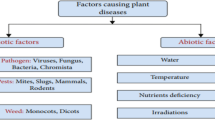Abstract
Leaf constitutes an important part of a plant as it gives prior information about its health. Timely and proper diagnosis of different pests, fungal and viral diseases of plants is indispensable for successful crop production. Sustainability in crop production is of utmost importance to meet the growing demand for food and support the economic growth of a country. In recent years, deep learning, a far superior method to traditional methods has paved the way in the field of digital image processing. Deep learning has the ability to process large numbers of features making it very powerful when dealing with unstructured data. It has achieved impressive results in the field of image classification. In this study, deep learning-based approach is adopted to identify and classify nine classes of tomato leaf diseases and mite infection along with healthy leaves and two types each of rice leaf diseases and pest infestation along with healthy leaves. For identification and classification of tomato leaf diseases, Convolutional Recurrent Neural Network architecture with Gated Recurrent Unit was used. To classify the rice leaf diseases and pest infestation, the concept of transfer learning using the same model trained with tomato leaf dataset was used due to insufficient and imbalance rice leaf datasets. The model achieved a success rate of 99.62% for the tomato leaf and 91.63% for the rice leaf.











Similar content being viewed by others
References
G R. Understanding categorical cross-entropy loss, binary cross-entropy loss, softmax loss, logistic loss, focal loss and all those confusing names. Blog 2018.
Ghosal S, Sarkar K. Rice leaf diseases classification using cnn with transfer learning. 2020 IEEE Calcutta Conference (CALCON) 2020;230–236.
Ghyar BS, Birajdar GK. Computer vision based approach to detect rice leaf diseases using texture and color descriptors. 2017 International Conference on Inventive Computing and Informatics. 2017;1074–1078.
Hasan MJ, Mahbub S, Alom MS, et al. Rice disease identification and classification by integrating support vector machine with deep convolutional neural network. 2019 1st International Conference on Advances in Science, Engineering and Robotics Technology (ICASERT). 2019;1–6.
Kawcher A, Tasmia RS, Syed Md. IA, et al. Rice leaf disease detection using machine learning techniques. Int Confer Sustainab Technol Indust 40 (STI). 2019. https://doi.org/10.1109/STI47673.2019.9068096.
Keren G, Schuller B. Convolutional rnn: an enhanced model for extracting features from sequential data. 2016 International Joint Conference on Neural Networks 2016;3412–3419.
Keren G, Schuller B. Convolutional rnn: An enhanced model for extracting features from sequential data. Int Joint Confer Neural Netw (IJCNN). 2016;3412–3419. https://doi.org/10.1109/IJCNN.2016.7727636.
Kosamkar PK, Kulkarni VY, Mantri K, et al. Leaf disease detection and recommendation of pesticides using convolution neural network. 2018 Fourth International Conference on Computing Communication Control and Automation (ICCUBEA) 2018;1–4.
Liu J, Wang X. Early recognition of tomato gray leaf spot disease based on mobilenetv2-yolov3 model. Plant Methods. 2020;16:83. https://doi.org/10.1186/s13007-020-00624-2.
Liu J, Wang X. Tomato diseases and pests detection based on improved yolo v3 convolutional neural network. Front Plant Sci. 2020;11. https://doi.org/10.3389/fpls.2020.00898.
Liu L, Zhou G. Extraction of the rice leaf disease image based on bp neural network. 2009 International Conference on Computational Intelligence and Software Engineering. 2009; pp. 1–3.
Lu Y, Yi S, Zeng N, et al. Identification of rice diseases using deep convolutional neural networks. Neurocomputing. 2017;267. https://doi.org/10.1016/j.neucom.2017.06.023.
Mim TT, Sheikh MH, Shampa RA, et al. Leaves diseases detection of tomato using image processing. 2019 8th International Conference System Modeling and Advancement in Research Trends (SMART). 2019;244–249. https://doi.org/10.1109/SMART46866.2019.9117437.
Mokhtar U, El-Bendary N, Hassenian AE, et al. Svm-based detection of tomato leaves diseases. IEEE Conf Intell Syst. 2014;323:641–52. https://doi.org/10.1007/978-3-319-11310-4_55.
Phadikar S, Sil J. Rice disease identification using pattern recognition techniques. 2008 11th International Conference on Computer and Information Technology 2008;420–423.
Philip TM, Anita HB. Rice grain classification using fourier transform and morphological features. Indian J Sci Technol. 2017. https://doi.org/10.17485/ijst/2017/v10i14/110468.
Prajapati HB, Shah JP, Dabhi VK. Detection and classication of rice plant diseases. Intell Decis Technol. 2016;11(3):357–73.
Ramesh S, Vydeki D. Rice blast disease detection and classification using machine learning algorithm. 2018 2nd International Conference on Micro-Electronics and Telecommunication Engineering (ICMETE) 2018;255–259.
Ramesh S, Vydeki D. Recognition and classication of paddy leaf diseases using optimized deep neural network with jaya algorithm. Inform Process Agric. 2020;7:249–60. https://doi.org/10.1016/j.inpa.2019.09.002.
Shrivastava VK, Pradhan MK, Minz S, et al. Rice plant disease classification using transfer learning of deep convolution neural network. ISPRS—The International Archives of the Photogrammetry, Remote Sensing and Spatial Information Sciences Vol XLII-3/W6:631–635. 2019. https://doi.org/10.5194/isprs-archives-XLII-3-W6-631-2019.
Vanitha V. Rice disease detection using deep learning. Int J Recent Technol Eng (IJRTE). 2019; 7(5S3):534–542.
Vetal S, Khule RS. Tomato plant disease detection using image processing. Int J Adv Res Comput Commun Eng. 2017;6:293–297. https://doi.org/10.17148/IJARCCE.2017.6651.
Wang Q, Qi F, Sun M, et al. Identification of tomato disease types and detection of infected areas based on deep convolutional neural networks and object detection techniques. Comput Intell Neurosci. 2019. https://doi.org/10.1155/2019/9142753.
Wu H, Prasad S. Convolutional recurrent neural networks for hyperspectral data classification. Remote Sens. 2017;9. https://doi.org/10.3390/rs9030298.
Author information
Authors and Affiliations
Corresponding author
Ethics declarations
Conflict of Interest
On behalf of all authors, the corresponding author states that there is no conflict of interest.
Additional information
Publisher's Note
Springer Nature remains neutral with regard to jurisdictional claims in published maps and institutional affiliations.
Kusal Roy, Dibyarup Pal, and Dipak Kumar Kole have contributed equally to this work.
Rights and permissions
Springer Nature or its licensor holds exclusive rights to this article under a publishing agreement with the author(s) or other rightsholder(s); author self-archiving of the accepted manuscript version of this article is solely governed by the terms of such publishing agreement and applicable law.
About this article
Cite this article
Mondal, D., Roy, K., Pal, D. et al. Deep Learning-Based Approach to Detect and Classify Signs of Crop Leaf Diseases and Pest Damage. SN COMPUT. SCI. 3, 433 (2022). https://doi.org/10.1007/s42979-022-01332-5
Received:
Accepted:
Published:
DOI: https://doi.org/10.1007/s42979-022-01332-5




